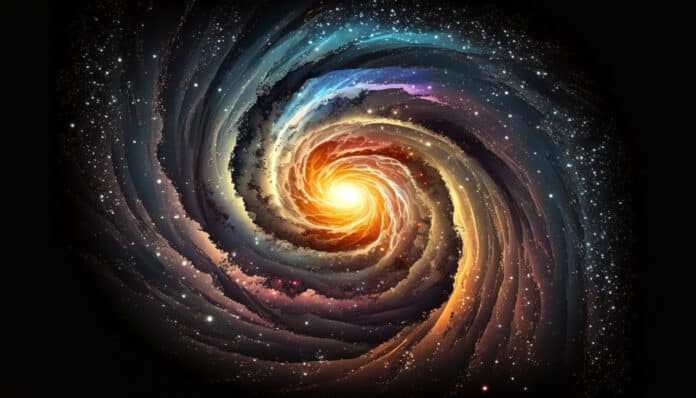Water is important for life. It is an important marker indicating areas of increased energy in which black holes and stars are formed. In essence, something important is going on where there is water vapor.
The J1135 galaxy, which is 12 billion light years away and created when the Universe was a “teenager,” 1.8 billion years after the Big Bang, has recently been identified by a new SISSA study as having a water distribution. This water map is the first ever to be obtained for such a far-off galaxy, and it has an incredible level of resolution.
According to the authors, this map can help them determine the physical processes within J1135 and shed light on the partially unclear dynamics surrounding the formation of stars, black holes, and galaxies themselves.
Francesca Perrotta, lead author of the study conducted by the Galaxy Observational and The theoretical Astrophysics (GOThA) team at SISSA, said, “Water can be found not only on Earth but anywhere in space, in different states. For example, in the form of ice, Water can be found in so-called molecular clouds, dense regions of dust and gas in which stars are born. Water acts like a cloak, covering the surface of interstellar dust grains, which form the building blocks of these molecular clouds and the principal catalysts of molecule formation in space.”
“At times, something breaks the stillness and coldness of these molecular clouds: the birth of a star, which releases heat, or a black hole which begins to aggregate matter, emitting energy. Radiation from stars and other sources can heat the icy Water, sublimating it into the gaseous phase. As the water vapor cools, it emits light in the infrared part of the spectrum. Astrophysicists can then observe this water vapor emission to map the regions of the galaxy where energy is produced, giving us unprecedented insights into how galaxies are formed.”
The mappings of other molecules, such as carbon monoxide (CO), also utilized in investigating these events, can be integrated with this information.
Dr. Perrotta explains that this study is valuable partly because it also extends our knowledge in an important area.
Dr. Perrotta explains, “How galaxies are formed isn’t yet clear. There are at least two possible scenarios, not necessarily alternative: one sees the aggregation of small galaxies to create larger ones, and the other sees the formation of stars in situ. Studies like ours help us to understand what is happening, specifically in that galaxy, but we can also potentially deduce more generic information from that.”
Future studies comparable to those previously made by the largest telescope ever deployed into space, the James Webb Space Telescope, could provide more details about J1135 and result in a more precise mapping of its molecules.
Prof. Andrea Lapi from the Astrophysics and Cosmology Group at SISSA, coauthor of the study and co-PI of the GOThA, comments: “The remarkable achievements obtained in this work have been possible thanks to a collaborative effort of a few senior researchers and a multitude of talented young scientists (Ph.D. students and postdocs) mastering different expertise, from analysis of observational data to numerical and data science techniques to theoretical modeling and interpretation.”
“I would like to stress the capability of our team members to rapidly acquire a robust background, redirect their actions, and produce cutting-edge original results in novel and unexplored research fields, like astrochemistry at high-redshift in the present case. This is the way research in (Astro)physics should proceed.”
Journal Reference:
- Francesca Perrotta, Marika Giulietti, Marcella Massardi, Giovanni Gandolfi, Tommaso Ronconi, Maria Vittoria Zanchettin, Quirino D’ Amato, Meriem Behiri, Martina Torsello, Francesco Gabrielli, Lumen Boco, Vincenzo Galluzzi, Andrea Lapi. The Way of Water: ALMA Resolves H2O Emission Lines in a Strongly Lensed Dusty Star-forming Galaxy at z ∼ 3.1. The Astrophysical Journal, 2023; 952 (1): 90 DOI: 10.3847/1538-4357/accd72
